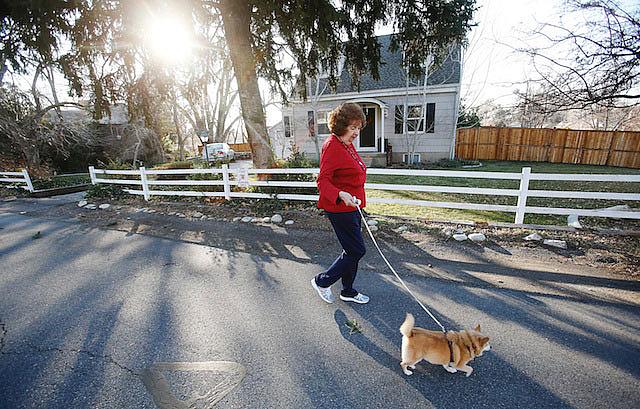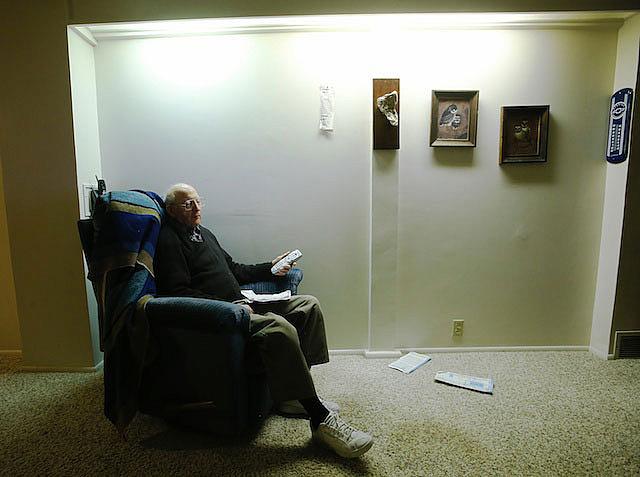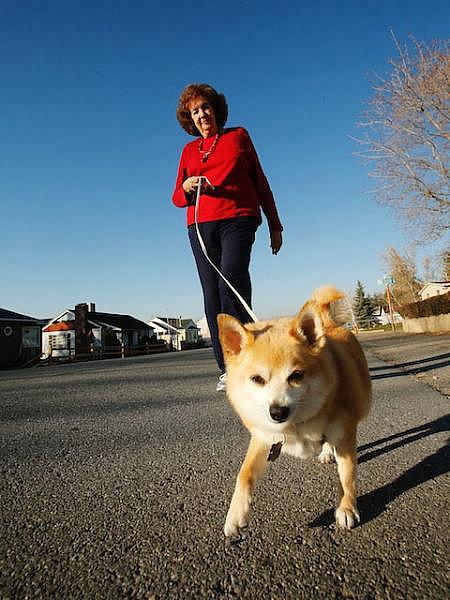Living Lonely Part 1: Seniors in Search of a Song
Lois M. Collins wrote the "Living Lonely" series for the Deseret News as a 2013 National Health Journalism Fellow. In the series, she examines the health effects of loneliness. Other stories in the series include:

Charlotte Jensen, 77, looks out of the front door with her dog Spike at her home in Salt Lake City, Nov. 26, 2013
Choir practice starts with a meditation, then the singers yawn their scales, mouths open wide. They stretch their arms and buzz like bees. They sing “ch” sounds to the tune of “Row, Row, Row Your Boat.” They laugh a lot.
These singers are older than you’d find in most choirs. Nancy Miles is 83. Even some younger ones are retired, like Joan Christensen, 69, or Carla and Mike McIntire, 66 and 68.
Over the summer, musician and composer Mary Lou Prince started this Encore Chorale for singers older than 55 because she knows music is magic. That is especially true for older singers, many of whom were invited to leave other choirs because of their age.
Charlotte Jensen, 77, walks her dog Spike near her home in Salt Lake City. She called the Encore Chorale a "godsend" because she's missed singing and meeting new people. Nov. 26, 2013.
“When I saw it in the newspaper, I felt like it was a godsend for me,” said choir member Charlotte Jensen, 77. She is long divorced, her children grown. “I am not someone who joins a lot of things.”
But she loves music: she loves to sing. And prior to the choir, she said she hadn’t been involved in much of anything for the past three years.
This choir is a hedge against loneliness.
Loneliness, as a medical matter, has begun to capture the attention of health experts worldwide. A growing body of research compares loneliness to documented health killers like smoking and obesity.
The fallout from loneliness is so expensive that England’s Department of Health is measuring the problem and recently launched its “Campaign to End Loneliness.” Former Prime Minister Tony Blair was the first to appoint a minister of joy, officially called the “Happiness Tsar,” a position that continues today. British experts say lonely people exercise less and drink more. They may end up prematurely in long-term care.
The United States lags behind Britain on this. There are pockets of activity, like the Encore Chorale, and researchers ponder loneliness and its implications. But most people don’t understand the devastating impact. Loneliness can kill.
The Loneliness Scale
The authors of the book “Loneliness,” John T. Cacioppo and William Patrick, say lonely people often experience a “deep sense of emptiness, worthlessness, lack of control and personal threat.” It’s not the same as social isolation, though the two may travel together. One may be lonely in a marriage, a family, a crowd.
Loneliness is a prompt, they say, “like hunger, thirst or physical pain — to motivate us to renew the connections we need to survive and prosper.”
Patrick, a science writer from Ipswich, Mass., said mankind has always found safety in numbers. “Being isolated, having connections frayed or severed, is the scariest thing there is. That’s why the most severe punishment, short of capital punishment, is solitary confinement.”
The worst part, he added, is those who need connections the most often find themselves the most terrified. In full fight-or-flight mode, they may act in ways that repel others instead of drawing them near.
Twenty-five years ago, the American Association of Retired Persons (AARP) asked Americans about close friends they could confide in. Most said they had three. In 2010, the most frequent response was zero.
The survey that year also showed more than one in three adults 45 and older said they have been lonely for a long time. According to an official U.S. measure, called the Loneliness Scale and developed by the University of California at Los Angeles, about 30 percent of Americans feel disconnected from others at any point in time.
Roger Thompson, 99, watches TV at his home in Salt Lake City, Friday, Dec. 3, 2013. Thompson stays active in his church and neighborhood, which wards off loneliness.
Experts estimate loneliness is about half-heritable, said Cacioppo, director of the University of Chicago Center for Cognitive and Social Neuroscience.
People inherit the degree of pain they feel at being isolated. Many are not bothered much, while others suffer intensely. Loneliness contributes to a depressed immune system, poor sleep quality, substance abuse, impulsive behavior, even dementia. It is a risk factor for poor health and premature death. Loneliness alters gene expression and boosts inflammation. It messes with one’s response to glucose, viruses and bacteria. Lonely people tend to be restless sleepers, thus often more fatigued and less able to detoxify the day’s stress.
Nobody wants to admit loneliness. It often feels like a personal failing, a stigma that must be denied.People with vision or hearing loss or inability to walk may become very isolated, increasing the likelihood of loneliness, Cacioppo said.
The Deseret News interviewed dozens of people who were happy to discuss people they know who are lonely or the steps they take to avoid it themselves. Not one volunteered to say, “I am lonely.”
Patrick and Cacioppo saw the same thing in their research. “We found a lot of people trying to hide it, not acknowledging it, who scored off the charts” on a scientific questionnaire that measured loneliness, Patrick said.
Singing loneliness away
The first “encore” choir was born in a 2001 study on creativity and aging by Georgetown University. Older people were carefully matched on factors like age, health and activity levels. One of each pair was enrolled in a program run by professional artists. The other was in a control group that got no program. Conductor Jeanne Kelly led a choir in Washington. Other sites tried dancing and theater. At least a dozen choirs are spin-offs of Kelly’s.
After a year, chorale members were more active and used less medication. They needed fewer doctor visits. The control group scores reflected more loneliness and less wellbeing. The results were published in 2006 in The Gerontologist journal.
Singing is like exercise in some ways. The deep breathing reduces anxiety. Singing releases pleasure-inducing endorphins and oxytocin, which lowers stress. Studies say depression and loneliness flee when people sing, particularly in groups. Research shows falling anxiety and rising life satisfaction for those who sing regularly — even if they’re not good at it. Musically trained people are also better able to hear as they get older, picking out pitch and timber through the general noise. The evidence is so compelling that the University of California San Francisco just launched a “Community of Voices” study to test group singing as an inexpensive tool to promote elderly wellbeing.
Prince is singularly suited to pairing music with interaction. She’s good-natured, but intensely gifted. She graduated from Brigham Young University with a master’s in composition, then studied in Paris. For more than two decades, she worked in Japan with instrument fellows, before returning to the United States. She loves seniors and can capture and keep the attention of those who may not have much musical experience.
First in choirs in Arizona and now in Utah, Prince has seen older people rebloom. They developed confidence in their voices and found community, she said. Her choirs have included people in their 90s and folks on oxygen.
It is not a community sing-along, Prince said. “They are learning to improve voices, how to breathe better, learning four-part music. Some come in and can’t read music. I can help them through that.” They also perform. They did a holiday concert last weekend. Her choirs have also sung in medical and long-term settings. “People in the choir feel good about themselves and realize they can minister to other people,” she said.
Semi-retired psychologist Rich Wortman, 86, jumped on a chance to join the choir Prince used to run near his Green Valley, Ariz., home. He’s worked with patients who are drinking, depressed, and lonely. “You get depressed if you don’t engage,” he said. “Homo sapiens, with the longest developmental dependency period in the animal kingdom, are not designed to be alone.”
The heart knows
You don’t have to join a choir to stave of loneliness. Roger Thompson, 99, jokes that if you know you need company, you should “get heart trouble. But you have to go to cardiac rehab three days a week. And you have to see the same faces every time until they become friends.”
In fact, Thompson had a heart attack. Afterwards, he was in better shape than before because he exercises. He studied nutrition and eats better. He brags about his excellent salmon loaf.
Despite a lot of time alone, he said he’s not lonely. He has children and grandchildren nearby. He likes television, especially athletic events and the history channel.
Thompson once had close male friends, but they died. Not many men live to his age. Sometimes, he helps younger neighbors, like the 77-year-old he took for haircuts. When he sees a need, he acts. He is cheerful, he said, but also a quiet person. “Maybe that’s why I’m not lonely. Some people have to have people around them all the time. I am not one of them.”
When his wife Pearl died 20 years ago, “I would sob. I was very lonely. It’s natural to have some lows, but I read, I do my own yard work, I grow tomatoes and am active in church.”
Emotional needs, too
As the number of senior citizens burgeons, more are exercising, socializing, dating and staying younger longer, said Pepper Schwartz, a sociologist at the University of Washington in Seattle.
With people living longer, the older they get, the more apt they are to become isolated. That risk is especially great for low-income and unhealthy people. People with money can afford group housing, caretaking and interaction, but “those who are poor or who don’t have children or who are unhealthy and housebound have no money to be in these places,” said Schwartz.
Some have children willing to take them in and care for them. That is usually considered a good thing. But many very lonely old people live with their children, she said. “They look like they are taken care of and, physically, they are. But they are not getting the interaction and stimulation they need.”
Adult children often have jobs and so many obligations that they are exhausted or just don’t think about it. Resources may be limited. An elderly parent waits alone all day, then the caregiver comes in with a “Hi, Mom, you doing okay?” serves dinner and disappears into other tasks. That’s not enough contact to ward off loneliness.
“We are not meant to be without interaction,” Schwartz said. “We know from baby studies of more than a half century ago that if you provide adequate nourishment, but not touch, their immune system is not as healthy.” In orphanages, kids who were held and touched survived, others died.
Men and women

Roger Thompson, 99, gets ready to shovel the sidewalk at his home in Salt Lake City, Friday, Dec. 3, 2013
“One fascinating piece of data about the elderly is that the more connections they have, the longer they will live,” said Dr. Norman Rosenthal, psychiatrist and clinical professor of psychiatry at Georgetown University School of Medicine. “They don‘t have to be close. It could be as banal as if you fall and a lot of people are checking on you, they catch you quicker; if you‘re sick, they see it quicker and take you to a doctor.”
Those who are frail medically but fine mentally may be loneliest, he said. They may find themselves in long-term care with those who are losing cognitive skills. They are not good company.
While some men focused — even obsessed — with building careers, family always came first for Thompson. He said he skipped a few promotions with the U.S. Postal Service because the hours would have taken him from his wife and children. That may be helping him now.
The elderly have one of the highest suicide rates — especially elderly white men. A decade ago, older people made up 13 percent of the population, but accounted for 19 percent of completed suicides, according to research by the University of Pittsburgh School of Medicine. The numbers are a bit confusing, because youths attempt suicide at a higher rate. The elderly succeed more often.
Decades ago, men now in their 80s were “facile, virile heads of households. But women have had a much greater success forging identities in other ways as well,” said Rosenthal, who wrote “The Gift of Adversity.”
“I see women who go yearly to have a girls’ weekend with friends from college. I will wager they are much better at phoning and Facebooking each other than the guys. Guys often build their identities around work — and when work ceases, their identities don’t evolve.” Thompson didn’t do that and his identity remains intact.
As Rosenthal points out, people in wheelchairs or walkers or who are ill and frail participate less or differently. Dementia, depression, a neurological illness like Parkinson’s can all sideline someone. “If you are someone with a frozen face or an embarrassing tremor, imagine wanting to have a cup of coffee with a friend when you can barely keep the coffee in a cup. The isolated don’t live as long.”
Addressing loneliness
Charlotte Jensen, 77, walks her dog Spike near her home in Salt Lake City, Nov. 26, 2013. Staying healthy and engaged helps prevent loneliness.
Families that want to help a loved one stay engaged must look at physical issues, from eating to maintain muscle mass to whether someone is hearing what goes on around her. But needs go beyond the physical.
Lunsford believes creative endeavors increase self-efficacy and mastery. People get hooked and want to do more. You don't get the same boost from watching something.
The choir, mostly women, has been meeting for 90 minutes every Thursday afternoon for several weeks, often practicing songs composed by Prince to showcase older voices. They know each other's names. They have moved on to learning tidbits about grandkids, chatting easily between vocal exercises and songs. At one point, Prince just stops for a second, her smile huge. “I wish I had a picture when you tenors carried the melody. You were so happy.”
“There's a thing that happens when we all finally know the music, kind of know each other and have been singing for two months,” said Christensen. “Especially when we are turned toward each other — a feeling of being one voice. It's exhilarating. When you get into a conversation and see each other's point of view, you get that feeling. It's being understood.”
It is the opposite of loneliness.
This story was originally published in the Deseret News.
Photos and video by Jeffrey D. Allred

